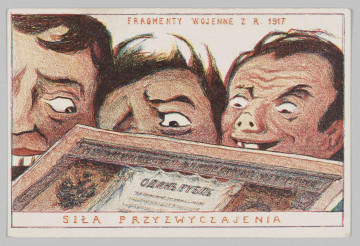
Force of habit
1917
National Museum in Lublin
Part of the collection: Legion postcards
The Polish Military Organisation started to function in 1914. Throughout the war period, it was subordinate to Józef Piłsudski. Its task was to prepare for armed struggle and to collect weapons. It brought together young people, first of all, members of the Riflemen's Teams. It saw Russia as its main enemy, and so it expanded its underground network into the Russian lands beyond the territory of the Kingdom of Poland.
POW was a paramilitary organisation with a developed structure. It had its own diversionary units. Individual districts were subordinate to the Supreme Command. The lowest unit was the section, consisting of eight people.
In 1915, most POW members joined the Polish Legions. Over the next two years, the number of POW members increased significantly. In 1917, two expeditions were set up – for areas under Austro-Hungarian occupation, with the headquarters in Lublin, and for areas under German occupation, with the headquarters in Warsaw. After the oath crisis, most of the Polish Military Organisation command found themselves in internment camps. The organisation survived, supporting the Provisional People's Government of the Republic of Poland formed in Lublin in November 1918. In the days preceding the regaining of independence, the POW members took part in disarming Germans and Austrians, remaining at the disposal of Józef Piłsudski, who was returning from Magdeburg. At the end of 1918, the organisation on Polish soil was disbanded. It continued to operate in conspiracy in Russia until 1921.
In 1933, Edward Wittig's Monument to the Fallen Soldiers of the Polish Military Organisation was erected in Warsaw. At that time, a series of postcards commemorating the activities of the Polish Military Organisation was issued. One of them depicted a parade of troops led before Józef Piłsudski by Stefan Pomarański, an officer of the Supreme Command.
Author / creator
Dimensions
cały obiekt: height: 14 cm, width: 8,8 cm
Object type
postcard
Technique
sepia
Material
paper
Creation time / dating
Creation / finding place
Owner
The National Museum in Lublin
Identification number
Location / status